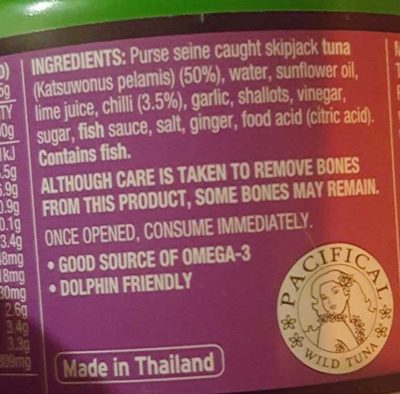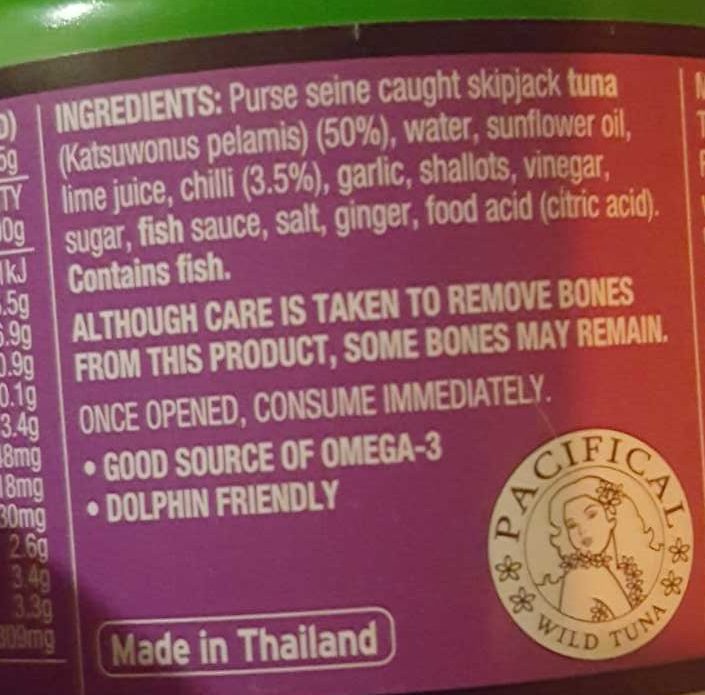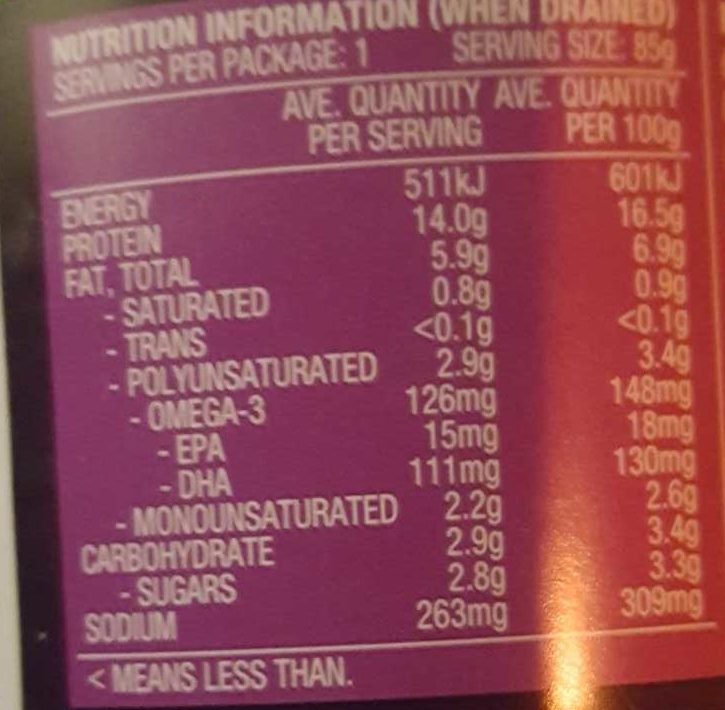Help us make food transparency the norm!
As a non-profit organization, we depend on your donations to continue informing consumers around the world about what they eat.
The food revolution starts with you!
John West Street Asian Indonesian Sambal, Chilli & Tuna - 85 g
John West Street Asian Indonesian Sambal, Chilli & Tuna - 85 g
This product page is not complete. You can help to complete it by editing it and adding more data from the photos we have, or by taking more photos using the app for Android or iPhone/iPad. Thank you!
×
Barcode: 9300462115771 (EAN / EAN-13)
Common name: Canned tuna with Sambal, Chilli and Tuna
Quantity: 85 g
Brands: John West
Categories: Seafood, Fishes and their products, Canned foods, Fishes, Fatty fishes, Canned fishes, Tunas, Canned tunas
Labels, certifications, awards:
Sustainable, Fishing method, Sustainable fishery, Dolphin Safe, Purse seine fishing, Sustainable Seafood MSC, Pacifical Wild Tuna
Origin of ingredients: FAO N°71
Manufacturing or processing places: Thailand
Countries where sold: Australia
Matching with your preferences
Health
Ingredients
-
14 ingredients
Purse seine caught skipjack tuna (katsuvornus pelamis) (50 %), water, sunflower oil, lime juice, chilli (3.5 %), garlic, shallots, vinegar, sugar, fish sauce, salt ginger, food acid (citric acid).Allergens: FishTraces: Fish
Food processing
-
Processed foods
Elements that indicate the product is in the 3 - Processed foods group:
- Ingredient: Sugar
- Ingredient: Vegetable oil
- Ingredient: Sauce
Food products are classified into 4 groups according to their degree of processing:
- Unprocessed or minimally processed foods
- Processed culinary ingredients
- Processed foods
- Ultra processed foods
The determination of the group is based on the category of the product and on the ingredients it contains.
Additives
-
E330 - Citric acid
Citric acid is a natural organic acid found in citrus fruits such as lemons, oranges, and limes.
It is widely used in the food industry as a flavor enhancer, acidulant, and preservative due to its tart and refreshing taste.
Citric acid is safe for consumption when used in moderation and is considered a generally recognized as safe (GRAS) food additive by regulatory agencies worldwide.
Ingredients analysis
-
Palm oil content unknown
Unrecognized ingredients: Purse-seine-caught-skipjack-tuna, Katsuvornus-pelamis, Salt-ginger, Food-acidSome ingredients could not be recognized.
We need your help!
You can help us recognize more ingredients and better analyze the list of ingredients for this product and others:
- Edit this product page to correct spelling mistakes in the ingredients list, and/or to remove ingredients in other languages and sentences that are not related to the ingredients.
- Add new entries, synonyms or translations to our multilingual lists of ingredients, ingredient processing methods, and labels.
If you would like to help, join the #ingredients channel on our Slack discussion space and/or learn about ingredients analysis on our wiki. Thank you!
-
Non-vegan
Non-vegan ingredients: Fish sauceSome ingredients could not be recognized.
We need your help!
You can help us recognize more ingredients and better analyze the list of ingredients for this product and others:
- Edit this product page to correct spelling mistakes in the ingredients list, and/or to remove ingredients in other languages and sentences that are not related to the ingredients.
- Add new entries, synonyms or translations to our multilingual lists of ingredients, ingredient processing methods, and labels.
If you would like to help, join the #ingredients channel on our Slack discussion space and/or learn about ingredients analysis on our wiki. Thank you!
-
Non-vegetarian
Non-vegetarian ingredients: Fish sauceSome ingredients could not be recognized.
We need your help!
You can help us recognize more ingredients and better analyze the list of ingredients for this product and others:
- Edit this product page to correct spelling mistakes in the ingredients list, and/or to remove ingredients in other languages and sentences that are not related to the ingredients.
- Add new entries, synonyms or translations to our multilingual lists of ingredients, ingredient processing methods, and labels.
If you would like to help, join the #ingredients channel on our Slack discussion space and/or learn about ingredients analysis on our wiki. Thank you!
-
Details of the analysis of the ingredients
We need your help!
Some ingredients could not be recognized.
We need your help!
You can help us recognize more ingredients and better analyze the list of ingredients for this product and others:
- Edit this product page to correct spelling mistakes in the ingredients list, and/or to remove ingredients in other languages and sentences that are not related to the ingredients.
- Add new entries, synonyms or translations to our multilingual lists of ingredients, ingredient processing methods, and labels.
If you would like to help, join the #ingredients channel on our Slack discussion space and/or learn about ingredients analysis on our wiki. Thank you!
: Purse seine caught skipjack tuna (katsuvornus pelamis), water, sunflower oil, lime juice, chilli 3.5%, garlic, shallots, vinegar, sugar, _fish_ sauce, salt ginger, food acid (citric acid)- Purse seine caught skipjack tuna -> en:purse-seine-caught-skipjack-tuna - percent_min: 8.33333333333333 - percent_max: 86
- katsuvornus pelamis -> en:katsuvornus-pelamis - percent_min: 8.33333333333333 - percent_max: 86
- water -> en:water - vegan: yes - vegetarian: yes - ciqual_food_code: 18066 - percent_min: 3.5 - percent_max: 44.75
- sunflower oil -> en:sunflower-oil - vegan: yes - vegetarian: yes - from_palm_oil: no - ciqual_food_code: 17440 - percent_min: 3.5 - percent_max: 31
- lime juice -> en:lime-juice - vegan: yes - vegetarian: yes - ciqual_food_code: 13067 - percent_min: 3.5 - percent_max: 24.125
- chilli -> en:chili-pepper - vegan: yes - vegetarian: yes - ciqual_food_code: 20151 - percent_min: 3.5 - percent: 3.5 - percent_max: 3.5
- garlic -> en:garlic - vegan: yes - vegetarian: yes - ciqual_food_code: 11000 - percent_min: 0 - percent_max: 3.5
- shallots -> en:shallot - vegan: yes - vegetarian: yes - ciqual_food_code: 20097 - percent_min: 0 - percent_max: 3.5
- vinegar -> en:vinegar - vegan: yes - vegetarian: yes - ciqual_food_code: 11018 - percent_min: 0 - percent_max: 3.5
- sugar -> en:sugar - vegan: yes - vegetarian: yes - ciqual_proxy_food_code: 31016 - percent_min: 0 - percent_max: 3.3
- _fish_ sauce -> en:fish-sauce - vegan: no - vegetarian: no - percent_min: 0 - percent_max: 3.3
- salt ginger -> en:salt-ginger - percent_min: 0 - percent_max: 3.3
- food acid -> en:food-acid - percent_min: 0 - percent_max: 3.3
- citric acid -> en:e330 - vegan: yes - vegetarian: yes - percent_min: 0 - percent_max: 3.3
Nutrition
-
Very good nutritional quality
⚠ ️Warning: the amount of fiber is not specified, their possible positive contribution to the grade could not be taken into account.⚠ ️Warning: the amount of fruits, vegetables and nuts is not specified on the label, it was estimated from the list of ingredients: 12This product is not considered a beverage for the calculation of the Nutri-Score.
Positive points: 5
- Proteins: 5 / 5 (value: 16.5, rounded value: 16.5)
- Fiber: 0 / 5 (value: 0, rounded value: 0)
- Fruits, vegetables, nuts, and colza/walnut/olive oils: 0 / 5 (value: 12.3411458333333, rounded value: 12.3)
Negative points: 4
- Energy: 1 / 10 (value: 601, rounded value: 601)
- Sugars: 0 / 10 (value: 3.3, rounded value: 3.3)
- Saturated fat: 0 / 10 (value: 0.9, rounded value: 0.9)
- Sodium: 3 / 10 (value: 313.944, rounded value: 313.9)
The points for proteins are counted because the negative points are less than 11.
Nutritional score: (4 - 5)
Nutri-Score:
-
Nutrient levels
-
Fat in moderate quantity (6.9%)
What you need to know- A high consumption of fat, especially saturated fats, can raise cholesterol, which increases the risk of heart diseases.
Recommendation: Limit the consumption of fat and saturated fat- Choose products with lower fat and saturated fat content.
-
Saturated fat in low quantity (0.9%)
What you need to know- A high consumption of fat, especially saturated fats, can raise cholesterol, which increases the risk of heart diseases.
Recommendation: Limit the consumption of fat and saturated fat- Choose products with lower fat and saturated fat content.
-
Sugars in low quantity (3.3%)
What you need to know- A high consumption of sugar can cause weight gain and tooth decay. It also augments the risk of type 2 diabetes and cardio-vascular diseases.
Recommendation: Limit the consumption of sugar and sugary drinks- Sugary drinks (such as sodas, fruit beverages, and fruit juices and nectars) should be limited as much as possible (no more than 1 glass a day).
- Choose products with lower sugar content and reduce the consumption of products with added sugars.
-
Salt in moderate quantity (0.785%)
What you need to know- A high consumption of salt (or sodium) can cause raised blood pressure, which can increase the risk of heart disease and stroke.
- Many people who have high blood pressure do not know it, as there are often no symptoms.
- Most people consume too much salt (on average 9 to 12 grams per day), around twice the recommended maximum level of intake.
Recommendation: Limit the consumption of salt and salted food- Reduce the quantity of salt used when cooking, and don't salt again at the table.
- Limit the consumption of salty snacks and choose products with lower salt content.
-
-
Nutrition facts
Nutrition facts As sold
for 100 g / 100 mlAs sold
per serving (85 g)Compared to: Canned tunas Energy 601 kj
(144 kcal)511 kj
(122 kcal)-5% Fat 6.9 g 5.87 g +1% Saturated fat 0.9 g 0.765 g -22% Monounsaturated fat 2.6 g 2.21 g +23% Polyunsaturated fat 3.4 g 2.89 g -2% Omega 3 fat 148 mg 126 mg -12% Eicosapentaenoic acid 0.018 g 0.015 g +15% Docosahexaenoic acid 0.13 g 0.111 g +8% Trans fat < 0.1 g < 0.085 g +52% Carbohydrates 3.4 g 2.89 g +78% Sugars 3.3 g 2.81 g +192% Fiber ? ? Proteins 16.5 g 14 g -15% Salt 0.785 g 0.667 g +1% Fruits‚ vegetables‚ nuts and rapeseed‚ walnut and olive oils (estimate from ingredients list analysis) 12.341 % 12.341 %
Environment
-
Eco-Score D - High environmental impact
⚠ ️The full impact of transportation to your country is currently unknown.The Eco-Score is an experimental score that summarizes the environmental impacts of food products.→ The Eco-Score was initially developped for France and it is being extended to other European countries. The Eco-Score formula is subject to change as it is regularly improved to make it more precise and better suited to each country.Life cycle analysis
-
Average impact of products of the same category: C (Score: 41/100)
Category: Tuna, raw
Category: Tuna, raw
- PEF environmental score: 0.72 (the lower the score, the lower the impact)
- including impact on climate change: 4.40 kg CO2 eq/kg of product
Stage Impact Agriculture
86.7 %Processing
0.0 %Packaging
2.5 %Transportation
9.3 %Distribution
1.2 %Consumption
0.3 %
Bonuses and maluses
-
Missing origins of ingredients information
Malus:
⚠ ️ The origins of the ingredients of this product are not indicated.
If they are indicated on the packaging, you can modify the product sheet and add them.
If you are the manufacturer of this product, you can send us the information with our free platform for producers.
-
Packaging with a medium impact
Malus: -10
Shape Material Recycling Impact Unknown Metal High ⚠ ️ The information about the packaging of this product is not sufficiently precise (exact shapes and materials of all components of the packaging).⚠ ️ For a more precise calculation of the Eco-Score, you can modify the product page and add them.
If you are the manufacturer of this product, you can send us the information with our free platform for producers.
Eco-Score for this product
-
Impact for this product: D (Score: 36/100)
Product: John West Street Asian Indonesian Sambal, Chilli & Tuna - 85 g
Life cycle analysis score: 41
Sum of bonuses and maluses: 0
Final score: 36/100
-
Carbon footprint
-
Equal to driving 2.3 km in a petrol car
440 g CO² per 100g of product
The carbon emission figure comes from ADEME's Agribalyse database, for the category: Tuna, raw (Source: ADEME Agribalyse Database)
Stage Impact Agriculture
74.9 %Processing
0.0 %Packaging
6.3 %Transportation
17.9 %Distribution
0.8 %Consumption
0.2 %
Packaging
-
Packaging with a medium impact
-
Packaging parts
(Metal)
-
Packaging materials
Material % Packaging weight Packaging weight per 100 g of product Metal
-
Transportation
-
Origins of ingredients
Missing origins of ingredients information
⚠ ️ The origins of the ingredients of this product are not indicated.
If they are indicated on the packaging, you can modify the product sheet and add them.
If you are the manufacturer of this product, you can send us the information with our free platform for producers.Add the origins of ingredients for this product Add the origins of ingredients for this product
Labels
Report a problem
-
Incomplete or incorrect information?
Category, labels, ingredients, allergens, nutritional information, photos etc.
If the information does not match the information on the packaging, please complete or correct it. Open Food Facts is a collaborative database, and every contribution is useful for all.











